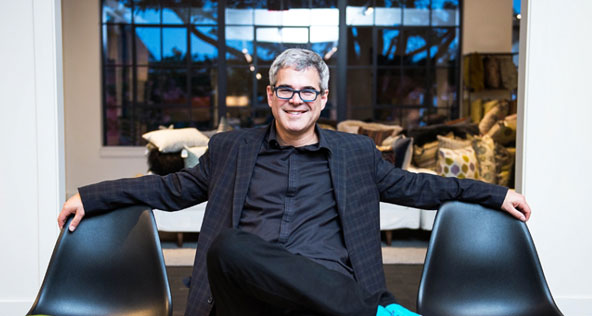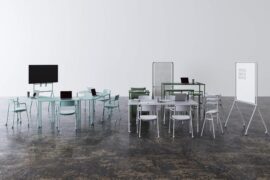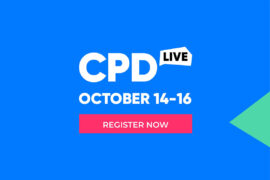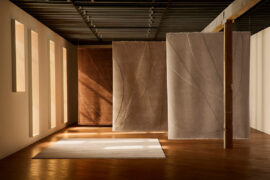DQ Editor Sophia Watson sits down with creative omnivore Eames Demetrios to talk all things film making, and keeping the famed Eames Office dynasty alive.

June 18th, 2014
What has been the journey, taking on the role as one of The Eames Office custodians?
I think what I saw was that if someone didn’t pay attention, the things we cared about would start to go away. After Ray died my mum basically inherited everything, which included some wonderful things but also included a lot of responsibility she had just raised five kids, so she was definitely up for a break, and had also had a lot of conversations with Charles and Ray over the years.
I’m a film maker, and when Ray dies I realised we had to document this amazing office and studio where they did their work, and I think in the process of making the [901 after 45 years of working] film, it opened my eyes up to the fact that I really care about the work – because I was so used to it, it took having to step outside of that to appreciate certain things. So when that happened I felt like I really wanted to do this, and what became clear was that I felt very strongly about the ideas as well as the objects. There were aspects of the office that; I don’t want to say “in our blood” because it was certainly being immersed in it, through osmosis and so on; that I already had a strong personal understanding about, but I also conducted about two hours of interviews with people who worked in the office, and went through archives that people still hadn’t gotten to, and so I felt incredibly lucky that I was able to understand my grandparents work from both a childhood memory and a more research-based analytical take. I wrote a book called the Eames Primer, and basically I still hold very strongly to the idea that even though the objects are amazing, the ideas are just as beautiful.
With these objects, these chairs, authenticity is extremely important to us. We protect it, we fight for it, we work hard for it – and that’s great, but it’s also important to share an idea like the “guest-host” relationship, and hoping that whoever hears about it, takes it into their life and makes their life better and richer. Those things are really important to us, to me. So that was the journey I went on.
One of the paradox’s of being a steward of work like this is that on the one hand you have the conservative part of it, where you’re trying to make sure these objects are done right, the way the were intended – but also, the way Charles and Ray were, you wouldn’t be doing them a service if you only looked backwards. So that’s where a lot of the education initiatives comes from. So we decided as a family that we would do our own work outside the office – which doesn’t mean we can’t be creative in the office; you know, my mother designed some really beautiful stools and tables, but we never sold them as Eames Office tables because we make such a big deal about authenticity that we really want to make sure that the brand communication is very clear.
Where we do new work is in education. For example we do workshops in ‘scale’ which is based on The Powers of Ten film, which communicates one of my theories that scale is the new geography, and if you don’t understand scale it’s a form of illiteracy today. So we built a lot of exercises and workshops around this idea. Because when you think about, so many of the opportunities and challenges that exist in the world today are on the extremes of scale – global warming; there is nothing wrong with carbon dioxide – it’s the amount of it, the scale of it; it is this tiny molecule and yet it’s changing everything. So the reason I call it “the new geography” is because when you know the map of the world you are fluent with scale. So as far as moving forward, we throw a lot of our energy into that. It’s great, because its not something Charles and Ray did, and yet I think they would totally dig it because we’ve created these workshops for schools and people, where they can participate and engage with the ideas.
The Eames office works quite closely wit Herman Miller and Vitra, what are some of the workshops, programs and education initiatives you run to keep the message and brand ideas alive?
The ‘Teaching Scale’ workshop is basically a program where a group of people come together and make their own “Powers of Ten” experience. We actually ran it in Melbourne at Federation Square about ten years ago. We also do ‘House of Cards’ workshops – they can be as simple as “draw and have fun” to really high-concept, critical discussions on form, function and so on, challenging people to look more and understand the making of things – because I feel like we are all a bit disconnected from making today. I guarantee you, if you had asked someone in the outback 75 years ago to copy a chair, they would have said “alright, well you’re going to have to pay me a weeks wages” where as now, the word ‘copy’ means dragging a file from one side of the desktop to another. And this raises the questions of how do you get people to understand the value of making if you don’t truly understand what it is?
The good news I think is that you look at major space; Farmers Markets, Extreme Sports, GoPro; there is a lot of desire for direct experience. Even 3D printing, which has its pluses and minuses, has the beginning of a digital generation connecting with making. And that is really important to understanding the value in authenticity.
How have the ideas you’ve been developing since childhood, your memories with your grandparents and more recently working with the Eames Office, impacted on your direction as a film maker?
I feel the way Charles and Ray inspired me the most is by example more than anything. I believe they were very good a surrendering to the design journey, to play with an idea and to follow it to see where it led them. It was an important lesson for me that they didn’t just do a drawing and say “well if we don’t make exactly that then why bother?” So many their designs have been a lesson in adaptive practice when it came to material, form, function – everything they did was an evolution – both within their lifetimes and still even now.
So for myself, most of the documentaries I’ve done, I don’t know exactly where I’m headed or where we were going to end up. I’m never really dialled into the final result.
As someone who believes in surrendering themselves to the journey and the process, where do you see the future – whether it be the Office or your film making – heading?
For the [Eames] Office that journey has really just started. I’ll give you an example, we donated 850,000 photographs the to Library of Congress, and a small selection of those are available online. There is just so much work to me done there, we’ve done a soft launch of the website, which will hopefully in the next few months be ‘officially’ launched. The aim there is to expand our reach and extend the catalogue of the products as well as the philosophy and ideas, the history and so on.
Only 45 of the original films are available in really good restoration quality, so that’s another project we’d love to get up and running. So we have a lot on we’d like to accomplish there, and then adding the education component is a whole other task. We’ve just launch a DVD called “Scale is the new geography”, because I used to do all the workshops but the demand became too much, so we made this DVD for teachers to be able to communicate and explore these ideas on our behalf, do the workshops and so on, and it’s been amazing.
I think in terms of surrendering ourselves to the design journey, the education aspect of the Office is particularly where this is relevant – meaning that we don’t know where or what the future of education will be. What can we do to engage more strongly on ideas such as making, I really can’t predict where this will land, or if it will ever land. But I’m excited to go on that journey.
Interview by Sophia Watson
Editor, DQ Magazine
Eames Demetrious
eamesdemetrios.com
INDESIGN is on instagram
Follow @indesignlive
A searchable and comprehensive guide for specifying leading products and their suppliers
Keep up to date with the latest and greatest from our industry BFF's!

London-based design duo Raw Edges have joined forces with Established & Sons and Tongue & Groove to introduce Wall to Wall – a hand-stained, “living collection” that transforms parquet flooring into a canvas of colour, pattern, and possibility.

Welcomed to the Australian design scene in 2024, Kokuyo is set to redefine collaboration, bringing its unique blend of colour and function to individuals and corporations, designed to be used Any Way!

Get the goss on the comings and goings within the design industry. Who has been promoted, who has moved to a new studio and where are practices setting up new offices?

St Stephen’s Junior School upgrade by CODA (now COX Architecture) creates a new heart for the school where the children can take ownership of the space.
The internet never sleeps! Here's the stuff you might have missed

Join CPD Live from 14-16 October for three days of live, interactive education – 100% online, 100% free, and packed with insights to keep your knowledge current and earn CPD points.

Armadillo collaborates with Barcelona artist Carla Cascales Alimbau on Gaia, a sculptural rug collection that translates fine art into handwoven form.